Plastics in Heritage Science: Analytical Pyrolysis Techniques Applied to Objects of Design
Abstract
:1. Introduction
- The morphology, the surface texture or the color prevent surface spectroscopic analysis;
- The surface composition is not representative of the bulk;
- Spectroscopy is not selective enough to resolve mixtures of different organic materials;
- The identification of the specific formulations is targeted (plasticizers, organic pigments, specific monomers and co-monomers, etc.);
- The information on degradation processes such as cross-linking or depolymerization is needed.
2. Results and Discussion
2.1. Surface Morphology
2.2. Sticky Surfaces
2.3. Surface Color
2.4. Surface Not Representative of the Bulk
2.5. Mixtures of Different Organic Materials and Evaluation of Degradation Processes
3. Materials and Methods
3.1. Samples
3.2. Analytical Pyrolysis-Gas Chromatography/Mass Spectrometry (Py-GC/MS)
3.3. Evolved Gas Analysis-Mass Spectrometry (EGA-MS)
4. Conclusions
Author Contributions
Funding
Acknowledgments
Conflicts of Interest
References
- Oosten, T.v.; Shashoua, Y.; Waentig, F.; Fachhochschule Koln; Fachbereich Restaurierung und Konservierung von Kunst- und Kulturgut; ICOM Committee for Conservation. Modern Materials Working Group. In Plastics in Art: History, Technology, Preservation; Anton Siegl Fachbuchhandlung GmbH: München, Germany, 2002. [Google Scholar]
- Shashoua, Y. Conservation of Plastics: Materials Science, Degradation and Preservation; Butterworth-Heinemann: Oxford, UK, 2008. [Google Scholar]
- Lattermann, G. PHEA – The Plastics Heritage European Association. Available online: http://e-plastory.com/index.php/e-plastory/article/view/Report/45 (accessed on 31 March 2020).
- Puls, J.; Wilson, S.A.; Hölter, D. Degradation of Cellulose Acetate-Based Materials: A Review. J. Polym. Environ. 2011, 19, 152–165. [Google Scholar] [CrossRef] [Green Version]
- Royaux, A.; Balcar, N.; Lavédrine, B.; Gilles, B.; Clémentine, B.; Cantin, S.; Fabre-Francke, I. Study of plasticizers, loss and exudation in plasticized polyvinylchloride-based heritage objects. In Proceedings of the 4th International Congress on Chemistry for Cultural Heritage, Bruxelles, Belgium, 6 July 2016. [Google Scholar]
- Toja, F.; Saviello, D.; Nevin, A.; Comelli, D.; Lazzari, M.; Levi, M.; Toniolo, L. The degradation of poly(vinyl acetate) as a material for design objects: A multi-analytical study of the effect of dibutyl phthalate plasticizer. Part 1. Polym. Degrad. Stab. 2012, 97, 2441–2448. [Google Scholar] [CrossRef]
- Saviello, D.; Pouyet, E.; Toniolo, L.; Cotte, M.; Nevin, A. Synchrotron-based FTIR microspectroscopy for the mapping of photo-oxidation and additives in acrylonitrile–butadiene–styrene model samples and historical objects. Anal. Chim. Acta 2014, 843, 59–72. [Google Scholar] [CrossRef]
- Comelli, D.; Toja, F.; D’Andrea, C.; Toniolo, L.; Valentini, G.; Lazzari, M.; Nevin, A. Advanced non-invasive fluorescence spectroscopy and imaging for mapping photo-oxidative degradation in acrylonitrile–butadiene–styrene: A study of model samples and of an object from the 1960s. Polym. Degrad. Stab. 2014, 107, 356–365. [Google Scholar] [CrossRef]
- Toja, F.; Saviello, D.; Nevin, A.; Comelli, D.; Lazzari, M.; Valentini, G.; Toniolo, L. The degradation of poly(vinyl acetate) as a material for design objects: A multi-analytical study of the Cocoon lamps. Part 2. Polym. Degrad. Stab. 2013, 98, 2215–2223. [Google Scholar] [CrossRef]
- Toja, F.; Nevin, A.; Comelli, D.; Levi, M.; Cubeddu, R.; Toniolo, L. Fluorescence and Fourier-transform infrared spectroscopy for the analysis of iconic Italian design lamps made of polymeric materials. Anal. Bioanal. Chem. 2011, 399, 2977–2986. [Google Scholar] [CrossRef]
- Picollo, M.; Bartolozzi, G.; Cucci, C.; Galeotti, M.; Marchiafava, V.; Pizzo, B. Comparative Study of Fourier Transform Infrared Spectroscopy in Transmission, Attenuated Total Reflection, and Total Reflection Modes for the Analysis of Plastics in the Cultural Heritage Field. Appl. Spectrosc. 2014, 68, 389–396. [Google Scholar] [CrossRef]
- Cucci, C.; Bigazzi, L.; Picollo, M. Fibre Optic Reflectance Spectroscopy as a non-invasive tool for investigating plastics degradation in contemporary art collections: A methodological study on an expanded polystyrene artwork. J. Cult. Herit. 2013, 14, 290–296. [Google Scholar] [CrossRef]
- Cucci, C.; Bartolozzi, G.; Marchiafava, V.; Picollo, M.; Richardson, E. Study of semi-synthetic plastic objects of historic interest using non-invasive total reflectance FT-IR. Microchem. J. 2016, 124, 889–897. [Google Scholar] [CrossRef] [Green Version]
- Nodari, L.; Ricciardi, P. Non-invasive identification of paint binders in illuminated manuscripts by ER-FTIR spectroscopy: a systematic study of the influence of different pigments on the binders’ characteristic spectral features. Herit. Sci. 2019, 7, 7. [Google Scholar] [CrossRef]
- Brunetti, B.; Miliani, C.; Rosi, F.; Doherty, B.; Monico, L.; Romani, A.; Sgamellotti, A. Non-invasive Investigations of Paintings by Portable Instrumentation: The MOLAB Experience. In Analytical Chemistry for Cultural Heritage; Mazzeo, R., Ed.; Springer International Publishing: New York City, NY, USA, 2017; pp. 41–75. [Google Scholar]
- Bitossi, G.; Giorgi, R.; Mauro, M.; Salvadori, B.; Dei, L. Spectroscopic Techniques in Cultural Heritage Conservation: A Survey. Appl. Spectrosc. Rev. 2005, 40, 187–228. [Google Scholar] [CrossRef]
- Saviello, D.; Toniolo, L.; Goidanich, S.; Casadio, F. Non-invasive identification of plastic materials in museum collections with portable FTIR reflectance spectroscopy: Reference database and practical applications. Microchem. J. 2016, 124, 868–877. [Google Scholar] [CrossRef]
- Germinario, G.; Van der Werf, I.D.; Sabbatini, L. Chemical characterisation of spray paints by a multi-analytical (Py/GC–MS, FTIR, μ-Raman) approach. Microchem. J. 2016, 124, 929–939. [Google Scholar] [CrossRef]
- Rosi, F.; Daveri, A.; Moretti, P.; Brunetti, B.G.; Miliani, C. Interpretation of mid and near-infrared reflection properties of synthetic polymer paints for the non-invasive assessment of binding media in twentieth-century pictorial artworks. Microchem. J. 2016, 124, 898–908. [Google Scholar] [CrossRef]
- Šuštar, V.; Kolar, J.; Lusa, L.; Learner, T.; Schilling, M.; Rivenc, R.; Khanjian, H.; Koleša, D. Identification of historical polymers using Near-Infrared Spectroscopy. Polym. Degrad. Stab. 2014, 107, 341–347. [Google Scholar] [CrossRef]
- Heginbotham, A.; Schilling, M. New evidence for the use of Southeast Asian raw materials in seventeenth-century Japanese export lacquer. In East Asian Lacquer: Material Culture, Science and Conservation; Archetype Books: London, UK, 2011; pp. 92–106. [Google Scholar]
- Scalarone, D.; Chiantore, O. Separation techniques for the analysis of artists’ acrylic emulsion paints. J. Sep. Sci. 2004, 27, 263–274. [Google Scholar] [CrossRef]
- La Nasa, J.; Orsini, S.; Degano, I.; Rava, A.; Modugno, F.; Colombini, M.P. A chemical study of organic materials in three murals by Keith Haring: A comparison of painting techniques. Microchem. J. 2016, 124, 940–948. [Google Scholar] [CrossRef]
- Bonaduce, I.; Colombini, M.P.; Degano, I.; Di Girolamo, F.; La Nasa, J.; Modugno, F.; Orsini, S. Mass spectrometric techniques for characterizing low-molecular-weight resins used as paint varnishes. Anal. Bioanal. Chem. 2013, 405, 1047–1065. [Google Scholar] [CrossRef]
- Bartolozzi, G.; Cucci, C.; Marchiafava, V.; Masi, S.; Picollo, M.; Grifoni, E.; Legnaioli, S.; Lorenzetti, G.; Pagnotta, S.; Palleschi, V. A multidisciplinary approach to the investigation of “La Caverna dell’Antimateria”(1958–1959) by Pinot Gallizio. Herit. Sci. 2014, 2, 29. [Google Scholar] [CrossRef] [Green Version]
- Lattuati-Derieux, A.; Thao-Heu, S.; Lavédrine, B. Assessment of the degradation of polyurethane foams after artificial and natural ageing by using pyrolysis-gas chromatography/mass spectrometry and headspace-solid phase microextraction-gas chromatography/mass spectrometry. J. Chromatogr. A 2011, 1218, 4498–4508. [Google Scholar] [CrossRef]
- Degano, I.; Modugno, F.; Bonaduce, I.; Ribechini, E.; Colombini, M.P. Recent advances in analytical pyrolysis to investigate organic materials in heritage science. Angew. Chem. Int. Ed. 2018, 57, 7313–7323. [Google Scholar] [CrossRef] [PubMed]
- Łucejko, J.J.; Zborowska, M.; Modugno, F.; Colombini, M.P.; Prądzyński, W. Analytical pyrolysis vs. classical wet chemical analysis to assess the decay of archaeological waterlogged wood. Anal. Chim. Acta 2012, 745, 70–77. [Google Scholar] [CrossRef] [PubMed]
- Carlesi, S.; Bartolozzi, G.; Cucci, C.; Marchiafava, V.; Picollo, M.; La Nasa, J.; Di Girolamo, F.; Dilillo, M.; Modugno, F.; Degano, I.; et al. Discovering “The Italian Flag” by Fernando Melani (1907–1985). Spectrochim. Acta Part A: Mol. Biomol. Spectrosc. 2016, 168, 52–59. [Google Scholar] [CrossRef]
- Marshall, G.L. Pyrolysis-Mass Spectrometry of Polymers II: Polyurethanes. Eur. Polym. J. 1983, 19, 439–444. [Google Scholar] [CrossRef]
- Tsuge, S.; Ohtani, H.; Watanabe, C. Pyrolysis-GC/MS Data Book of Synthetic Polymers; Elsevier: Oxford, UK, 2011. [Google Scholar]
- Oosten, T.v. Pur Facts Conservation of Polyurethane Foam in Art and Design; Amsterdam University Press: Amsterdam, NL, USA, 2011. [Google Scholar]
- La Nasa, J.; Biale, G.; Ferriani, B.; Colombini, M.P.; Modugno, F. A pyrolysis approach for characterizing and assessing degradation of polyurethane foam in cultural heritage objects. J. Anal. Appl. Pyrolysis 2018, 134, 562–572. [Google Scholar] [CrossRef]
- Sabatini, F.; Nacci, T.; Degano, I.; Colombini, M.P. Investigating the composition and degradation of wool through EGA/MS and Py-GC/MS. J. Anal. Appl. Pyrolysis 2018, 135, 111–121. [Google Scholar] [CrossRef]
- Tamburini, D.; Łucejko, J.J.; Modugno, F.; Colombini, M.P. Combined pyrolysis-based techniques to evaluate the state of preservation of archaeological wood in the presence of consolidating agents. J. Anal. Appl. Pyrolysis 2015, 122, 429–441. [Google Scholar] [CrossRef]
- Polymer Science. Available online: https://polymerdatabase.com (accessed on 31 March 2020).
- Guggenberger, S.K. Neoprene (Polychloroprene)-Based Solvent and Latex Adhesives. In Handbook of Adhesives; Skeist, I., Ed.; Springer US: Boston, MA, USA, 1990; pp. 284–306. [Google Scholar]
- Moldoveanu, S.C. Analytical Pyrolysis of Synthetic Organic Polymers; Elsevier Science: Oxford, UK, 2005. [Google Scholar]
- Ghelardi, E.; Degano, I.; Colombini, M.P.; Mazurek, J.; Schilling, M.; Learner, T. Py-GC/MS applied to the analysis of synthetic organic pigments: characterization and identification in paint samples. Anal. Bioanal. Chem. 2015, 407, 1415–1431. [Google Scholar] [CrossRef]
- Sonoda, N. Characterization of organic azo-pigments by pyrolysis–gas chromatography. Stud. Conserv. 1999, 44, 195–208. [Google Scholar] [CrossRef]
- Sumi, M.; Chokki, Y.; Nakai, Y.; Nakabayashi, M.; Kanzawa, T. Studies on the structure of polyurethane elastomers. I. NMR spectra of the model compounds and some linear polyurethanes. Die Makromol. Chem. Macromol. Chem. Phys. 1964, 78, 146–156. [Google Scholar] [CrossRef]
- Tallmadge, J.N.; Diwanji, A.P.; Weih, M.A.; Wilhem, W.C. Polyurethane compositions. United States Patent 6262217, 17 July 2001. [Google Scholar]
- Sundholm, N.K. Polyurethanes cured with the reaction product of 2-chloroaniline; 2, 5-dichloroaniline; and formaldehyde. United States Patent 3379691A, 23 April 1968. [Google Scholar]
- Petrović, Z.S.; Ferguson, J. Polyurethane elastomers. Prog. Polym. Sci. 1991, 16, 695–836. [Google Scholar] [CrossRef]
- Noble, K.-L. Waterborne polyurethanes. Prog. Org. Coat. 1997, 32, 131–136. [Google Scholar] [CrossRef]
- Rosi, F.; Chieli, A.; Ferriani, B.; Miliani, C. MOLAB access at the Italian Triennial Design Museum: non-invasive portable spectroscopies unveiling the composition of iconic objects of the Italian design. In Proceedings of the plastics heritage congress. History, Limids and Possibilities, Lisbon, Portugal, 29–31 May 2019. [Google Scholar]
- La Nasa, J.; Biale, G.; Sabatini, F.; Degano, I.; Colombini, M.P.; Modugno, F. Synthetic materials in art: a new comprehensive approach for the characterization of multi-material artworks by analytical pyrolysis. Herit. Sci. 2019, 7, 8. [Google Scholar] [CrossRef] [Green Version]
- Orsini, S.; La Nasa, J.; Modugno, F.; Colombini, M.P. Characterization of Aquazol polymers using techniques based on pyrolysis and mass spectrometry. J. Anal. Appl. Pyrolysis 2013, 104, 218–225. [Google Scholar] [CrossRef]
Sample Availability: Samples of the objected of design were of minimal dimension and they are not available. |
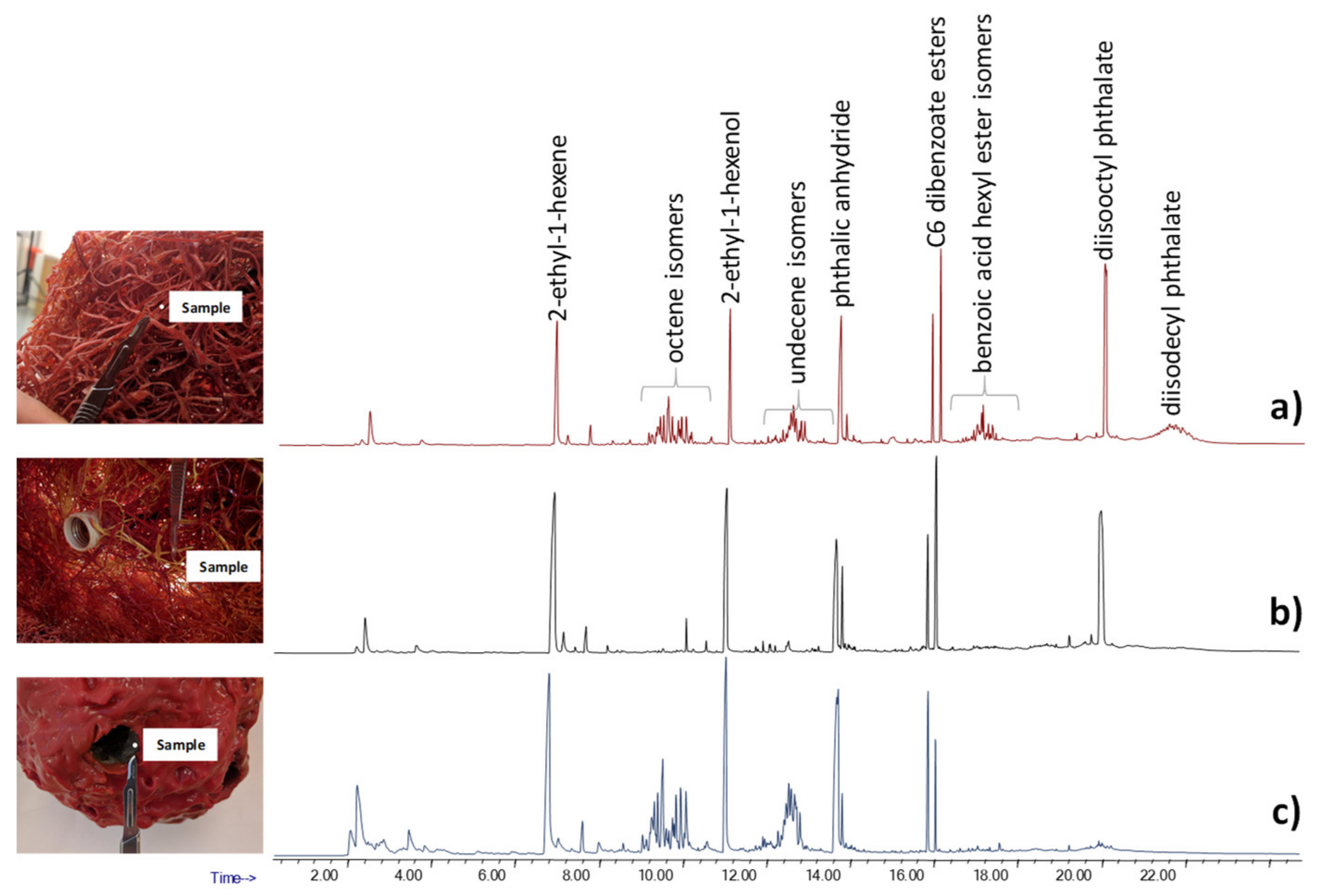
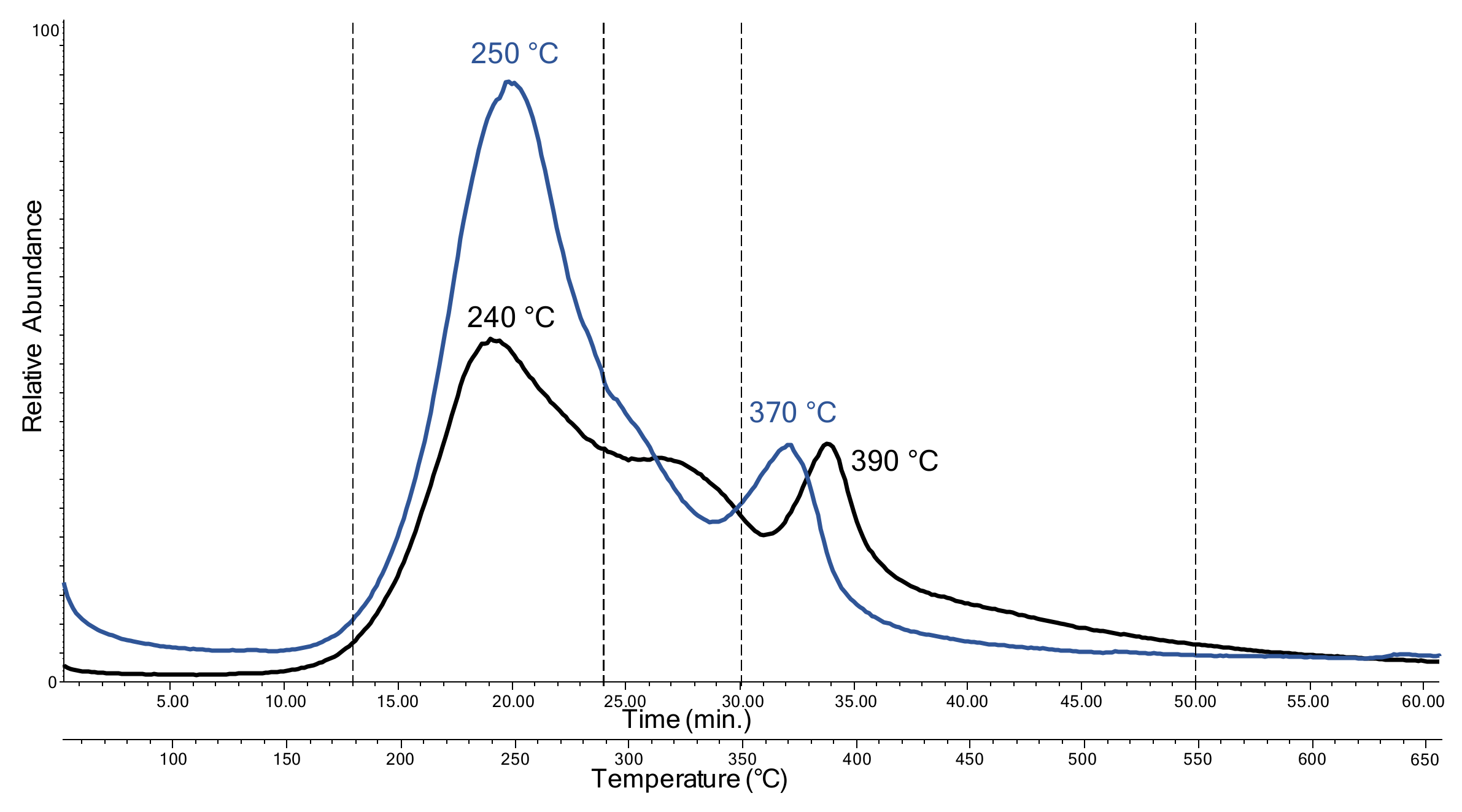
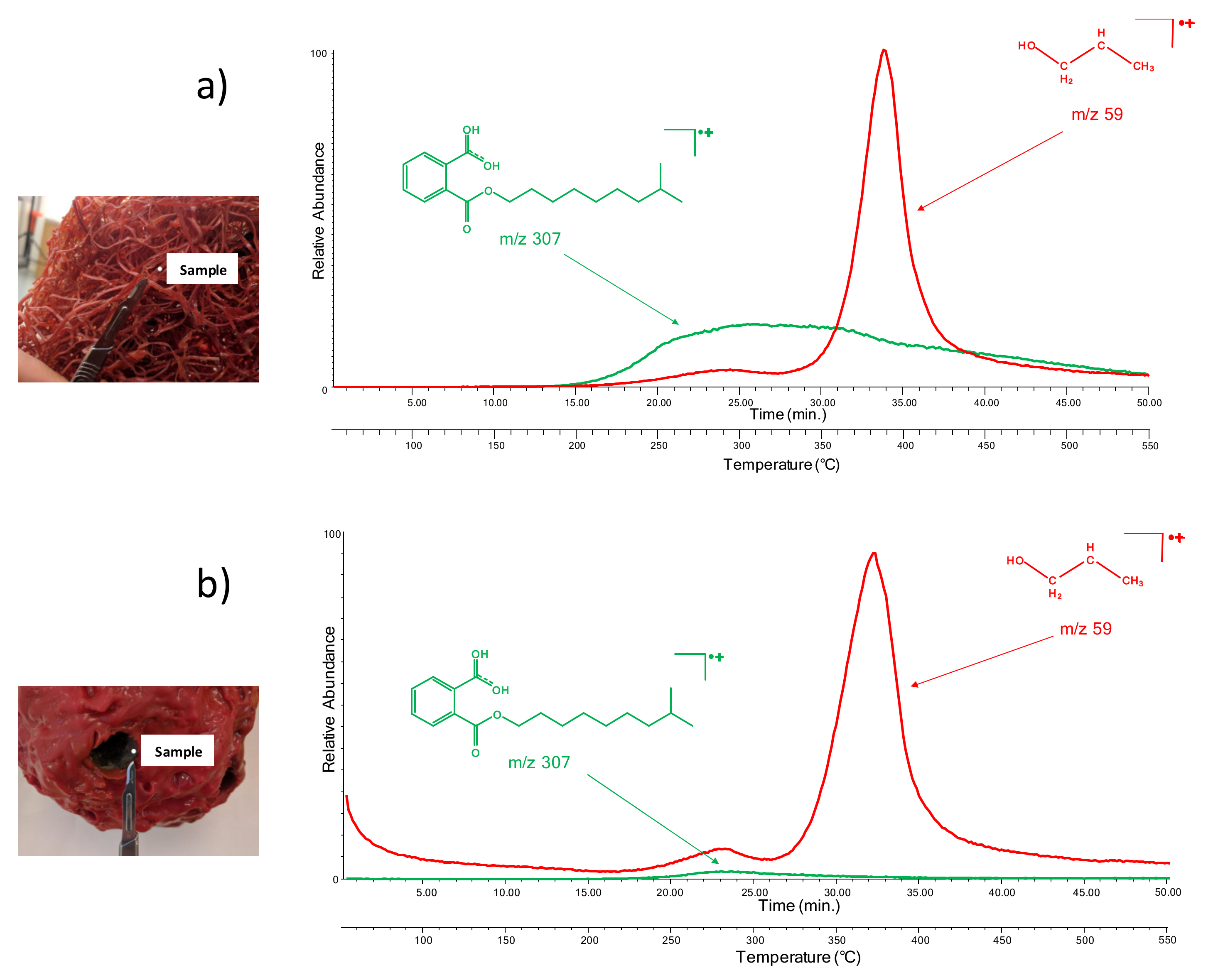
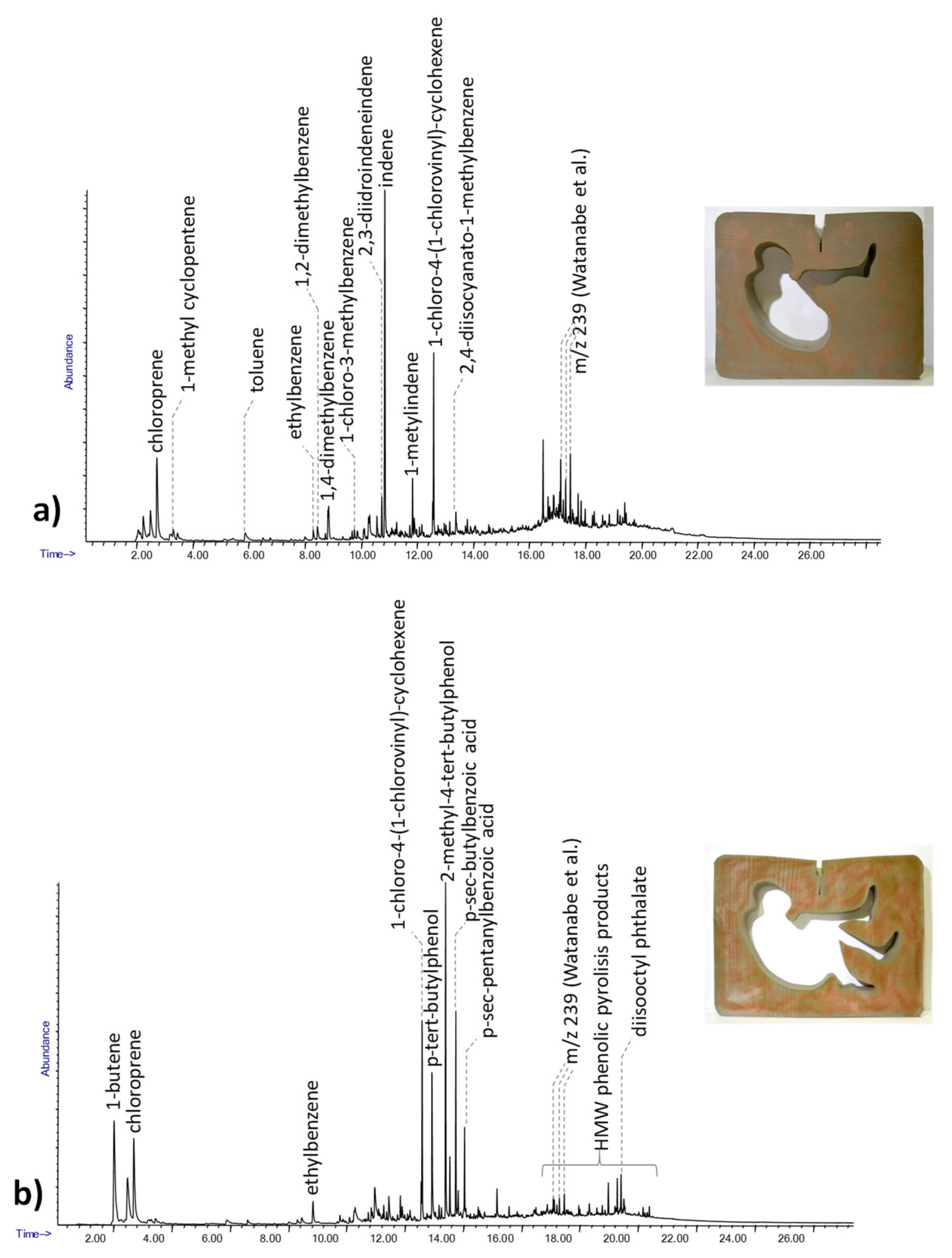
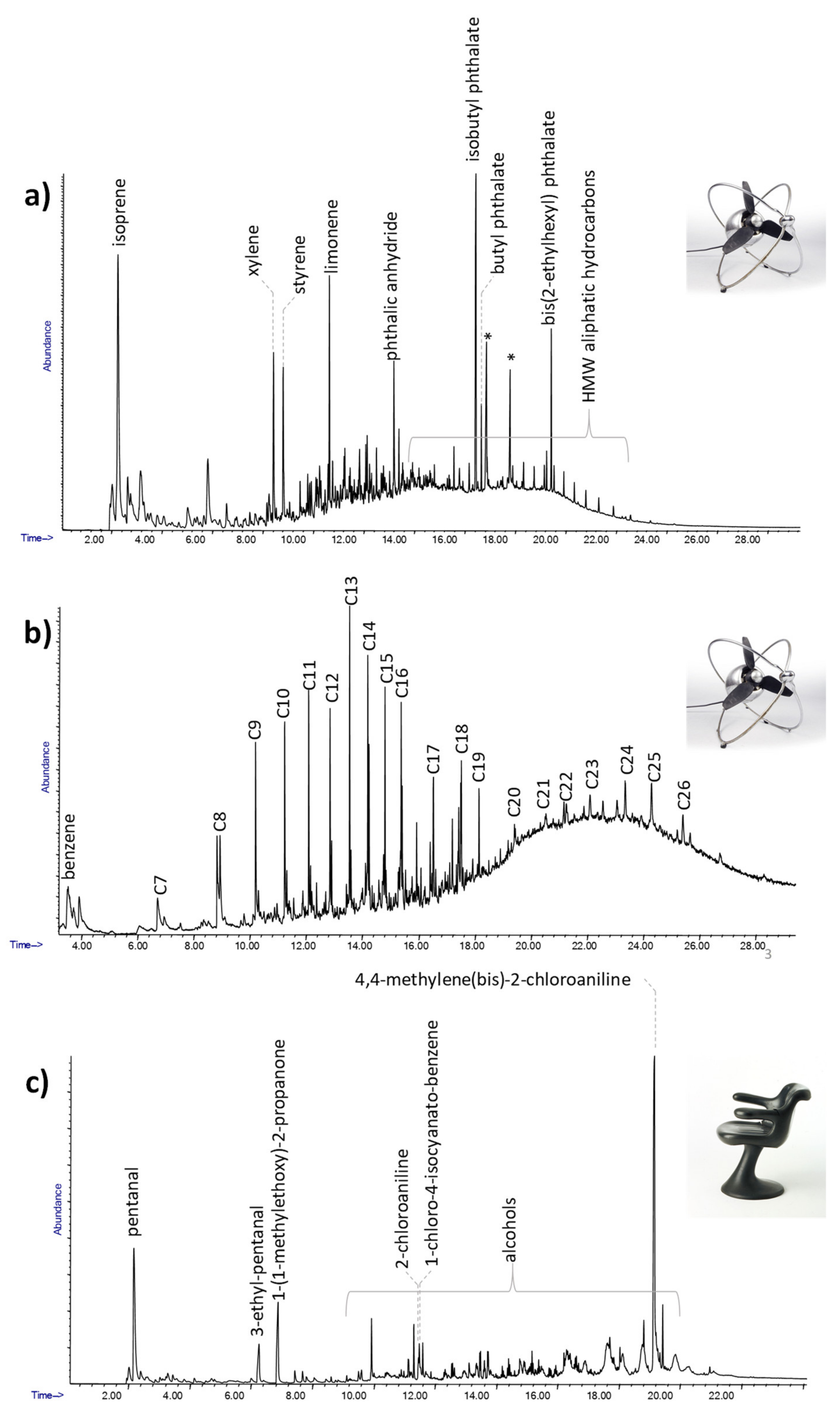
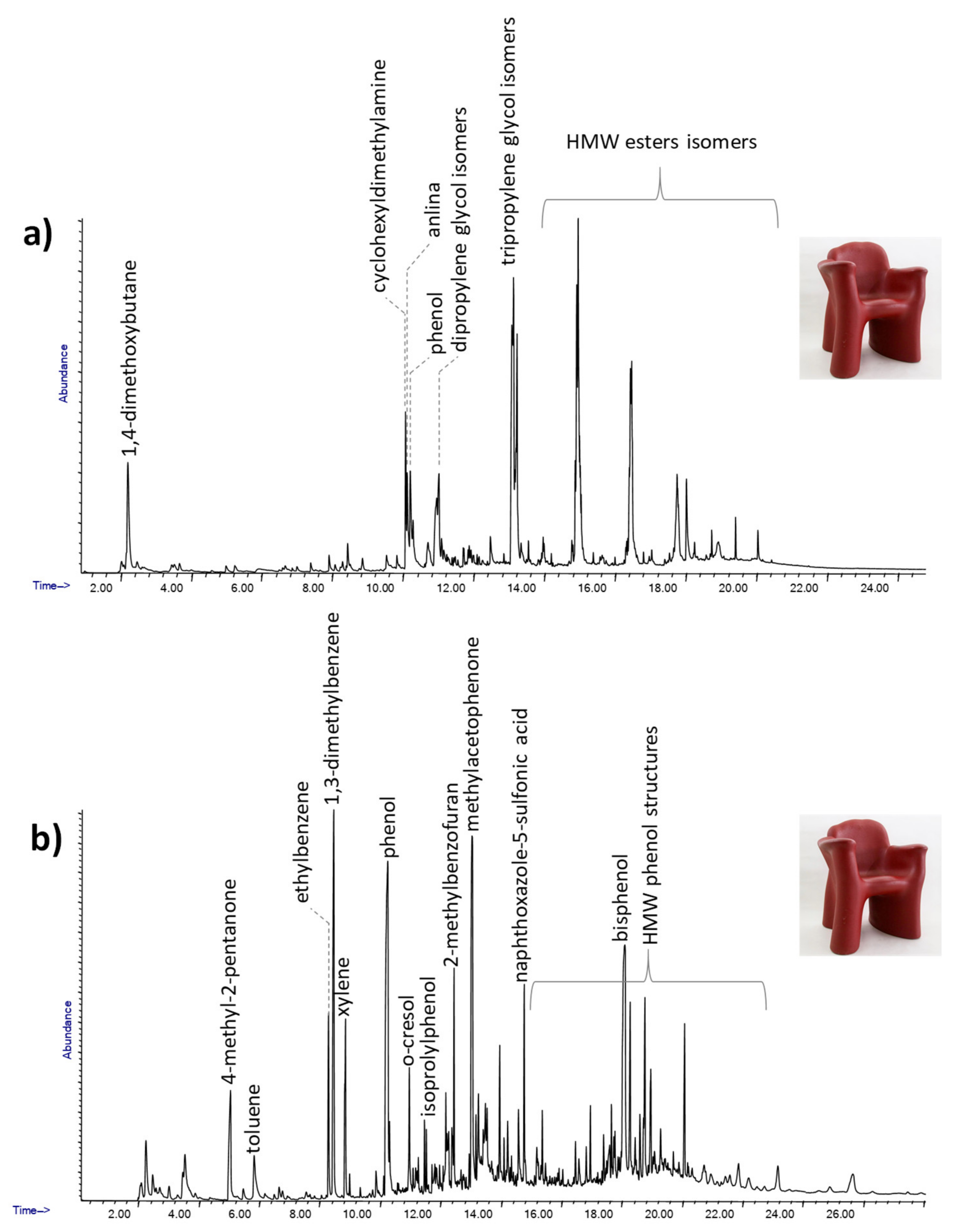

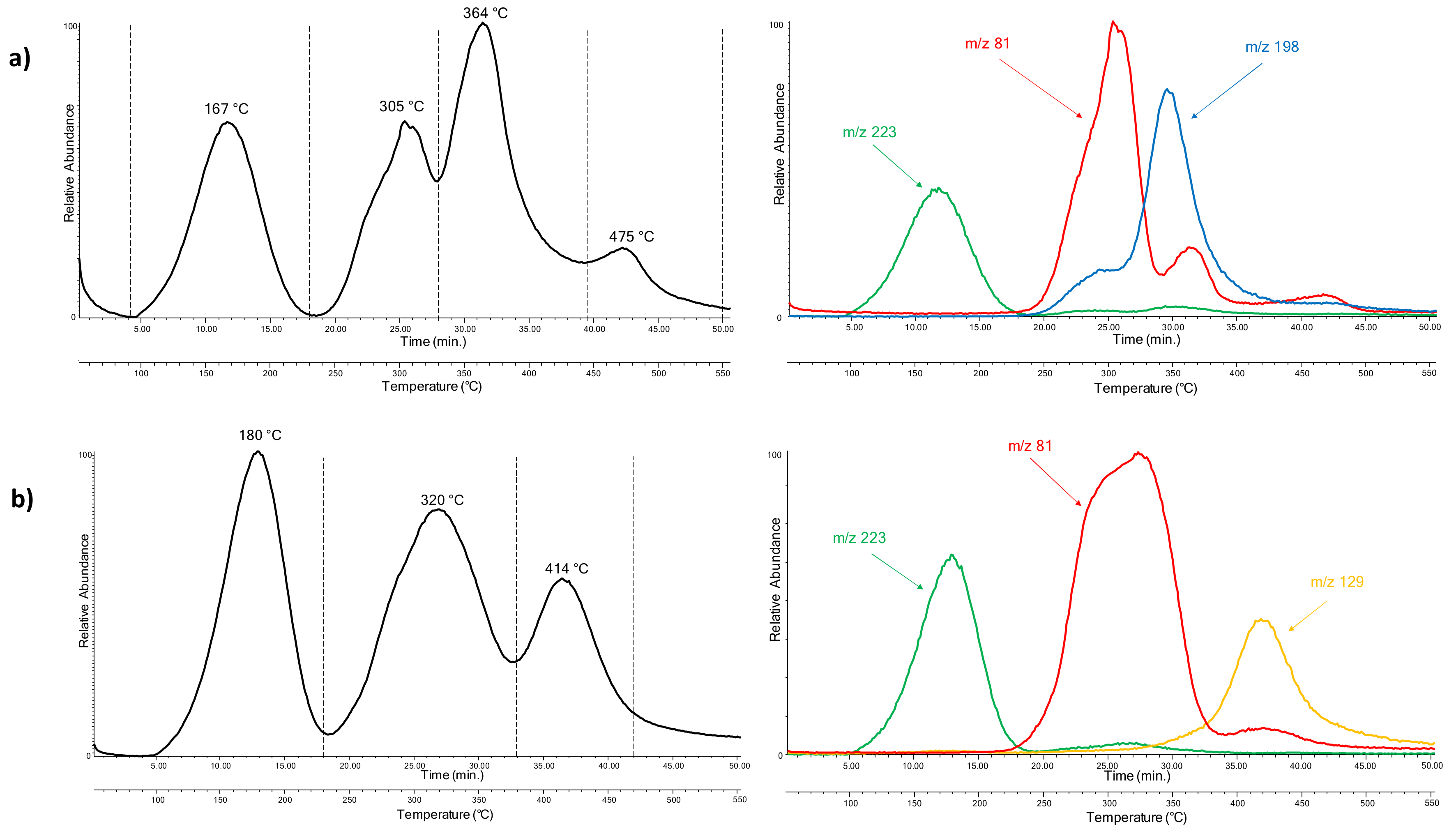
| Object and Designers/Artists | Year | Issues Presented by the Object | Features that Hindered Non-Invasive Spectroscopic Analysis | |
|---|---|---|---|---|
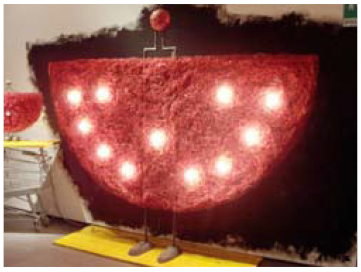 | Angel Lamp Gaetano Pesce Manufactured by the artist (Italy) | 1994 | Unknown plastic | Sample morphology (the material is made of intricate 1 mm large filaments of plastic) |
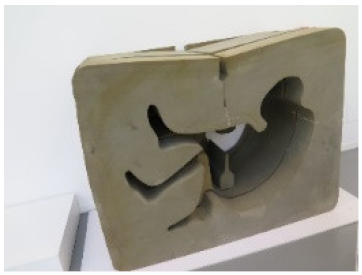 | CONTENITOREUMANO N. 1 Ico Parisi Francesco Somaini Manufactured by the artist (Italy) | 1968–1969 | Detachment of the glue uniting the different PU layers | Black and porous surface |
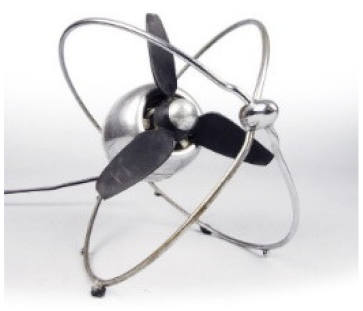 | VE 505 Ezio Pirali Zerowatt - F.E.R. (Italy) | 1953 | Loss of elasticity, exudation, embrittlement and decohesion | Black surface |
 | IN 301 Angelo Mangiarotti Zanotta (Italy) | 1969 | Structural damages | Black and porous surface |
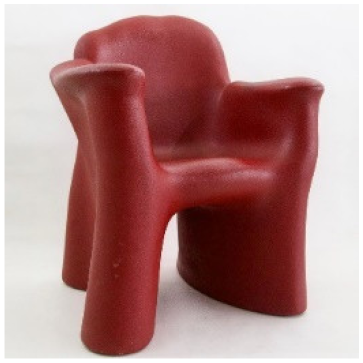 | Dalilauno (modello 351) Gaetano Pesce Cassina (Italy) | 1980 | Unknown polyurethane type | Surface not representative of the bulk of the material |
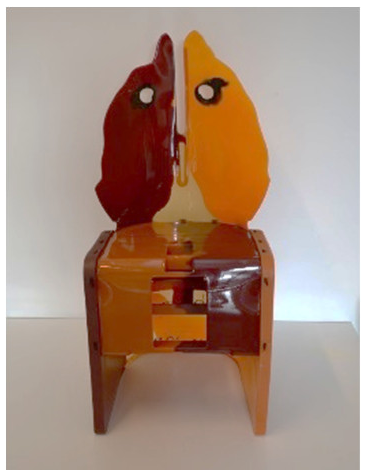 | Nobody’s Perfect 1 Gaetano Pesce Zerodisegno–Quattrocchio S.r.l. (Italy) | 1993 | Deformation and loss of flexibility | FTIR profile not conclusive for the identification of the material |
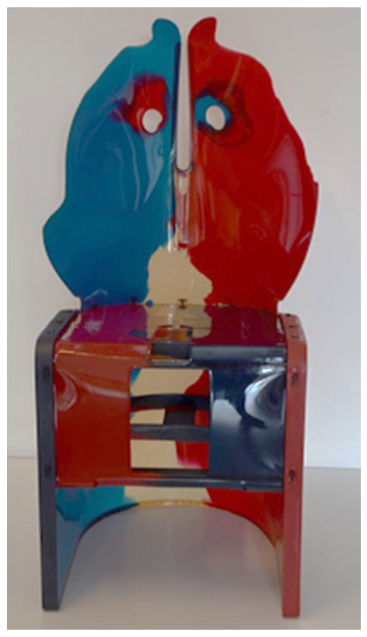 | Nobody’s Perfect 2 Gaetano Pesce Zerodisegno–Quattrocchio S.r.l. (Italy) | 1993 | Deformation and loss of flexibility | FTIR profile not conclusive for the identification |
 | Nobody’s Perfect 3 Gaetano Pesce Zerodisegno–Quattrocchio S.r.l. (Italy) | 1993 | Deformation and loss of flexibility | FTIR profile not conclusive for the identification |
© 2020 by the authors. Licensee MDPI, Basel, Switzerland. This article is an open access article distributed under the terms and conditions of the Creative Commons Attribution (CC BY) license (http://creativecommons.org/licenses/by/4.0/).
Share and Cite
Nasa, J.L.; Biale, G.; Ferriani, B.; Trevisan, R.; Colombini, M.P.; Modugno, F. Plastics in Heritage Science: Analytical Pyrolysis Techniques Applied to Objects of Design. Molecules 2020, 25, 1705. https://doi.org/10.3390/molecules25071705
Nasa JL, Biale G, Ferriani B, Trevisan R, Colombini MP, Modugno F. Plastics in Heritage Science: Analytical Pyrolysis Techniques Applied to Objects of Design. Molecules. 2020; 25(7):1705. https://doi.org/10.3390/molecules25071705
Chicago/Turabian StyleNasa, Jacopo La, Greta Biale, Barbara Ferriani, Rafaela Trevisan, Maria Perla Colombini, and Francesca Modugno. 2020. "Plastics in Heritage Science: Analytical Pyrolysis Techniques Applied to Objects of Design" Molecules 25, no. 7: 1705. https://doi.org/10.3390/molecules25071705
APA StyleNasa, J. L., Biale, G., Ferriani, B., Trevisan, R., Colombini, M. P., & Modugno, F. (2020). Plastics in Heritage Science: Analytical Pyrolysis Techniques Applied to Objects of Design. Molecules, 25(7), 1705. https://doi.org/10.3390/molecules25071705









